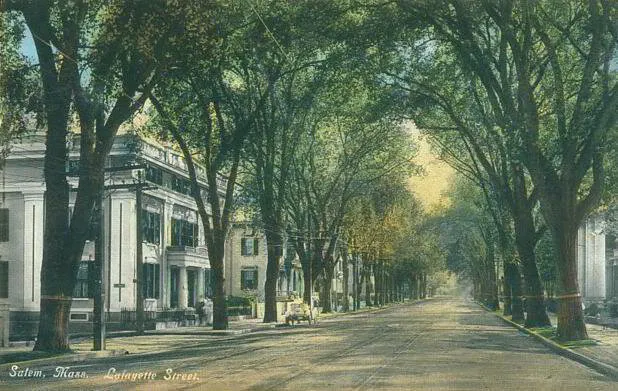The Story of the American Elm
 The American Elm tree became well known to most of the Eastern United States and Southeastern Canada by the mid 1800’s. Treasured for its shade, its elegant vase-shape, and the ability to grow seemingly anywhere, this native was thought to be a perfect tree and was seen lining urban streets and rural roadsides everywhere. Its wood, which is hard, bendable and not easily split due to its interlocking grain, was deemed desirable for housing construction and furniture making.
The American Elm tree became well known to most of the Eastern United States and Southeastern Canada by the mid 1800’s. Treasured for its shade, its elegant vase-shape, and the ability to grow seemingly anywhere, this native was thought to be a perfect tree and was seen lining urban streets and rural roadsides everywhere. Its wood, which is hard, bendable and not easily split due to its interlocking grain, was deemed desirable for housing construction and furniture making.
Learn how to identify an American Elm by clicking here.
By the early 1920’s however, Europe was experiencing high losses in their elm tree populations due to a pervasive syndrome of wilt and dieback. Britain alone lost 25 million Elm trees over a 30 year period. Dutch scientists were the first to isolate the problem. A parasitic fungus was confirmed to be causing European elm tree death in 1921, thus giving rise to the name of the syndrome; Dutch Elm Disease(DED). It was later found that the fungus originated in Asia, where Asian species of elm are highly resistant to the disease. There, healthy native specimens are able to manufacture chemicals which prevent the fungal spores from germinating within the inner bark of the tree. Once the fungus was introduced to European elms with no natural defenses however, mortality was high.
In a post-war boom, the rising need for lumber prompted some wood imports from Europe to North America. A shipment of logs from Europe in the ‘30s of a species of elm similar to the American Elm is thought to have carried the causal fungus of DED, Ceratocystis ulmi into New York, then to Ohio. It is reported that the disease reached eastern Canada during the second world war, and spread into Ontario in the late 1960s and into Manitoba and Saskatchewan during the ‘70s and early ‘80s. Within a few decades, elm trees were dying by the hundreds of thousands including many trees that were more than fifty years old and had huge trunk diameters and canopies covering hundreds of square metres.
How does Dutch Elm Disease cause tree death?
Spores of the fungus are deposited into the vascular systems of elm trees through feeding wounds chewed by elm bark beetles, the main carriers of the fungus. Once in contact with the inner bark, the spores germinate into rapidly growing fungal threads. These threads in turn clog the tree’s vascular systems and prevent the transport of water and nutrients. The affected leaves begin to wilt, yellow and die. Eventually, the entire tree is lost.
Both native and European elm bark beetles are carriers of the fungus. The introduced European bark beetle, which is smaller and more effective at gaining entry to the xylem stream than our native beetle, has hastened the spread of the disease and the demise of elms in North America. Human activity has contributed to the transmission of the fungus from one area to another through logging activity and the transport of firewood. On top of the losses from disease, an aggressive removal aimed at curbing the spread of the disease has also contributed to the decimated numbers.
Management efforts
Many early management efforts involved the spraying of trees with insecticides in an attempt to kill the bark beetle but had little effect on such a very small pest in a very large tree. The breakthrough in protecting and saving elms from DED in Canada came when the focus shifted from stopping the beetles to stopping the fungus. If enough fungicide could be injected into the tree’s vascular system, then a spore introduced by a beetle wouldn’t be able to germinate, and the tree would not become infected. This method has worked at successfully saving ten of thousands of elms over the past three decades. It is, however, a treatment that is expensive, time consuming and is best repeated every 2 to 3 years.
Thankfully, over time elm cultivars have been developed that are more successful in fighting this devastating fungus. Most of these trees are hybrids that cross various species of American, Asian and European elms observed to naturally resist the disease. Not all of these hybrids have the characteristic vase-shaped, arching branch structure, mature height, or leaf shape of the beloved American elm, but some come close. Some also have resistance to other diseases and pests that trouble elms.
Management of Dutch elm disease has come a long way since the days of spraying DDT from helicopters but it still requires action on the part of homeowners and municipalities. Quick recognition and removal of diseased trees is key to the overall management, and individual trees might still be best managed one by one. Even DED resistant trees can be susceptible if they become stressed. Proper siting, early growth management through proper pruning over the early years and protection against stressors are key. Since elm trees are self-sterile, seed production is enhanced when they are grown in a grove such as they are here.
Moving toward an increase in species diversity along streetscapes and within tree plantings is crucial to avoid the detrimental losses when one species is affected by a pest or disease. In many urban areas the elm tree was replaced by ash trees only to more recently have them also lost from damage associated with the introduced emerald ash borer.
Even within their first 25 years, the fast growing elm can reach more than 15 metres tall with a trunk circumference of 1.5 metres and a crown spread of 12.5 metres. It is hoped that in a relatively short time period, these majestic trees will soon again be making a significant contribution to the urban and rural landscape in Eastern Canada.
Image at the top: By Cephas - Own work, CC BY-SA 3.0, https://commons.wikimedia.org/w/index.php?curid=6976771
Image below: Colourized 1910 postcard of Lafayette Street, Salem, Massachusetts.. By Unknown photographer - Reproduced from an original postcard published by the Hugh C. Leighton Company, Portland, Maine, Public Domain, https://commons.wikimedia.org/w/index.php?curid=20252188



